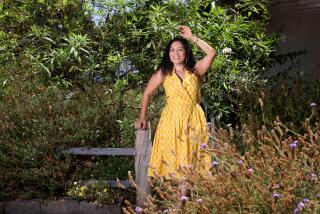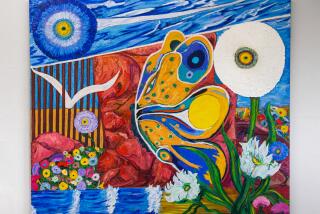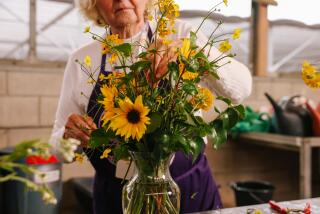Fostering Flights of Fancy
- Share via
Of all the insects, butterflies are probably the most admired. Heads turn as these delicate, colorful winged insects flit in and light up the garden.
“It’s so exciting to see butterflies,” said Jonell Schlund, who has a butterfly garden at her home in the hills of Orange. “Butterflies are captivating and magical, and I’m always delighted when they visit my garden.”
Schlund created her butterfly garden several years ago after she and her nephew, Michael Arakelian, 10, visited the Victoria Butterfly Gardens on Vancouver Island in British Columbia.
“That visit was incredible,” Schlund said. “We had the opportunity to see thousands of live butterflies from around the world. We decided to plant our own butterfly garden.”
Schlund and Arakelian discovered what attracts and feeds local butterflies and their larvae. Since starting their butterfly haven, they’ve been visited by a variety of colorful visitors.
“We’ve seen the cabbage white, painted lady, California blue, monarch and swallowtail,” Schlund said. “I really enjoy spending free time in the garden with my nephew. Seeing butterflies is an educational experience that gives me an opportunity to re-energize and reflect on the beauty of life.”
Butterfly gardens have become popular over the years, said Donald Stokes, who with his wife, Lillian, wrote “Stokes Butterfly Book: The Complete Guide to Butterfly Gardening, Identification and Behavior” (Little Brown, 1991, $13) and “Stokes Beginner’s Guide to Butterflies” (Little Brown, 1991, $9), which identifies 100 of the most common butterflies across the country.
“There is a tremendous interest in butterfly gardens, and the good news is that there are many things you can do to attract these beautiful insects,” said Stokes, who lives in Massachusetts during the summer and Florida in the winter. “The home gardener can make a difference and increase butterfly populations.”
The trick to attracting and keeping butterflies in the garden is providing them with two sets of plants. Host, or larval, plants provide females a place to lay their eggs and for the resulting caterpillars to feed, and nectar plants give adult butterflies food.
“You can plant just nectar sources for butterflies and they will visit your garden, but to attract many butterflies and increase their populations, you also need the host plants,” Stokes said.
Some species only eat leaves of certain host plants. For example, the monarch will only feed on milkweed, and the cabbage white butterfly feeds on plants in the brassica family, such as cabbage and broccoli. Other butterflies use grasses as host plants.
To have a garden full of butterflies, it’s important to understand that caterpillars are an important part of this habitat, said entomologist David Kellum, who is with the San Diego County Department of Agriculture.
“Home gardeners sometimes get upset when caterpillars eat their plant leaves, but you can’t get butterflies without them,” Kellum said. “It’s important to have plants on hand that you can sacrifice for the larvae to feed on.” Such host plants attract butterflies and keep them in your yard.
Some gardeners prefer to plant host plants in containers, when possible, and put them in an out-of-the-way location, said horticulturist Wendy Proud, product manager for Azusa-based wholesale grower Monrovia, whose plants are sold at nurseries throughout Southern California.
Three years ago the growers teamed up with the National Audubon Society to educate consumers about how to garden for butterflies and birds.
Nectar-producing plants are important because they feed adult butterflies so that they can mate. Proud suggests growing as many of them as possible.
If space is limited for nectar plants, there are a variety of things you can do to feed butterflies anyway, said Carl Johnson, owner of the Victoria Butterfly Gardens. The gardens breed 35 species of tropical butterflies that they import from various countries such as Costa Rica.
“Place dishes of a sweet liquid around the garden filled with brightly colored sponges and the butterflies will feed on the liquid,” Johnson said. “We’ve found that the favorite ‘sugar water’ of our butterflies is Gatorade. Just be careful where you place the dishes so that you avoid ants.”
You can also find butterfly feeders, which are similar to those for hummingbirds.
Southern California, with its mild weather, is fortunate to have a long butterfly season compared with most areas of the country, generally lasting from spring through fall.
“Butterflies need a lot of heat,” Stokes said.
They can’t fly until their body temperature reaches 85 to 100 degrees, depending on the species. In the morning, they will bask in a warm, sunny spot, such as on rocks or a stone wall, he said.
Butterflies rarely venture into the shade, don’t tend to come out on overcast days, and they require locations that are calm and not windy.
Gardeners who want butterflies in their garden should also avoid the use of pesticides.
“Butterflies are insects and pesticides will kill them,” Proud said.
This includes BT (Bacillus thuringiensis), which will kill caterpillars.
To further encourage butterflies in your garden, incorporate plants at a variety of heights because butterflies feed at different levels in the garden. The larger the butterfly, the higher the plant should be. Smaller butterflies tend to stay low to the ground.
BUTTERFLY PLANTS
AND INFORMATION RESOURCES:
* The UCI Arboretum will be holding a spring sale with plants that attract butterflies on May 19 and May 20. (949) 824-5833.
* The Fullerton Arboretum has plant sales on weekends. (714) 278-3579 or https://www.arboretum.fullerton.edu.
* Flowerdale Nursery, (714) 633-9200.
* M&M; Nursery, (714) 538-8042.
* Heard’s Country Gardens, (714) 894-2444.
* Upland Nursery, (714) 538-4500.
* Brita’s Old Town Gardens, (562) 430-5019
* The Monarch Program offers plant sources and information. (800) 606-6627.
* Information about Donald and Lillian Stokes’ books is available at https://www.stokesbirdsathome.com
* Victoria Butterfly Gardens, (877) 722-0272.
* On the Web, https://www.butterflies.com offers more information.
(BEGIN TEXT OF INFOBOX / INFOGRAPHIC)
Don’t Just Wing It: Plants Must Feed Larvae, Adults
Butterflies need host plants on which their larvae can feed and nectar plants from which adults can feed.
A varied habitat works best. Use as many plants from the host and nectar lists below, suggests butterfly expert and author Donald Stokes.
Also keep in mind butterflies are very plant specific. If you desire a certain type of butterfly in your garden, find out what host and nectar plants are necessary to attract it.
Monarchs, for instance, will lay their eggs only on milkweed.
Some plants are all-around favorites for many butterflies; buddleia has nectar that attracts monarchs, painted ladies and swallowtails.
HOST PLANTS
Ash tree
Aster
Bermuda grass
Birch tree
Broccoli
Cabbage
Carrot
Cassia
Cauliflower
Celery
Citrus
Clover
Crabgrass
Dill
Elm
Hollyhock
Lupine
Mallow
Milkweed
Mustard
Nasturtium
Nettle
Parsley
Passion vine
Radish
Silver lace vine
Southern Magnolia
Spiraea
Tulip-poplar tree
NECTAR PLANTS
Abelia grandiflora
Armeria
Aster
Black-eyed susan vine
Buddleia
Butterfly weed
Milkweed
Caryopteris
Coreopsis
Cosmos
Dandelion
Daylily
Echinacea
Evening primrose
Gaillardia
Gloriosa daisy
Heliotrope
Honeysuckle
Hydrangea quercifolia
Impatiens
Lantana
Liatris
Ligustrum
Lilac
Marigold
Mint
Penstemon
Pentas
Petunia
Phlox
Pincushion flower
Potentilla
Rosemary
Salvia
Snapdragon
Sunflower
Verbena bonariensis
Yarrow
Zinnia






